Abstract
The reflex response to stretch in most contracting human muscles includes both a short-latency, probably monosynaptic, excitatory component, and a longer-latency, polysynaptic excitation. However, it has been claimed that stretch of the jaw-closing muscles evokes only the short-latency response in masseter. This question was re-examined, using controlled stretches of varied rates and durations. Very brief, rapid stretches analogous to the stimuli used to investigate the 'jaw-jerk' reflex in earlier studies evoked a prominent excitatory peak in the electromyogram at monosynaptic latency excitation, but little or no longer-latency excitation. This response could be produced even by stimuli that were barely detectable by the subject. However, this prominent electrical response did not produce a measurable increase in biting force. In contrast, slower stretches evoked both a short- and a longer-latency excitatory response in the surface electromyogram, as in most limb muscles. It is shown that the absence of a long-latency excitatory response in earlier studies can be explained by the powerful reflex disfacilitation of the motoneurones that occurred at the end of the brief stretches used. Depending on the duration of the stretch, this disfacilitation is often sufficient to mask or abolish the long-latency reflex. The reflex response to stretches was not markedly affected by blocking the activation of mechanoreceptors around the teeth with local anaesthetic, indicating that receptors around the teeth cannot be playing more than a minor role in the response. The stretch-induced increase in force became greater as the velocity of the stretch decreased.
Full text
PDF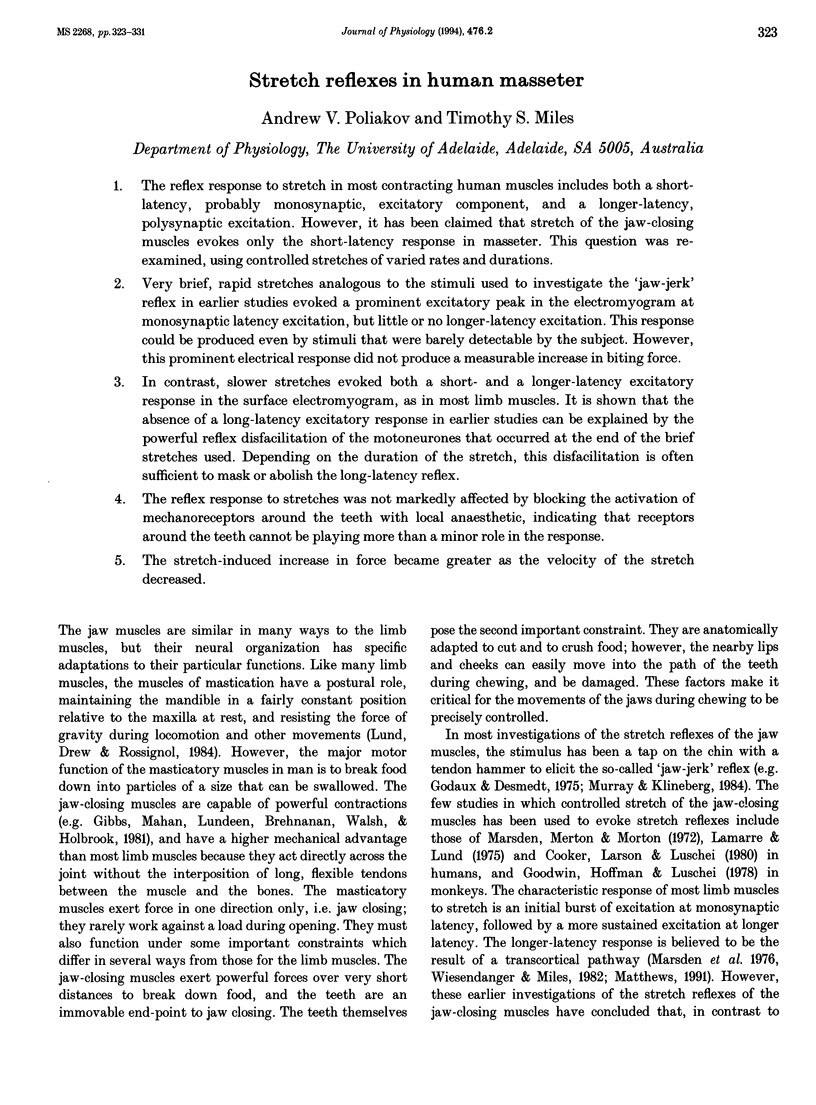
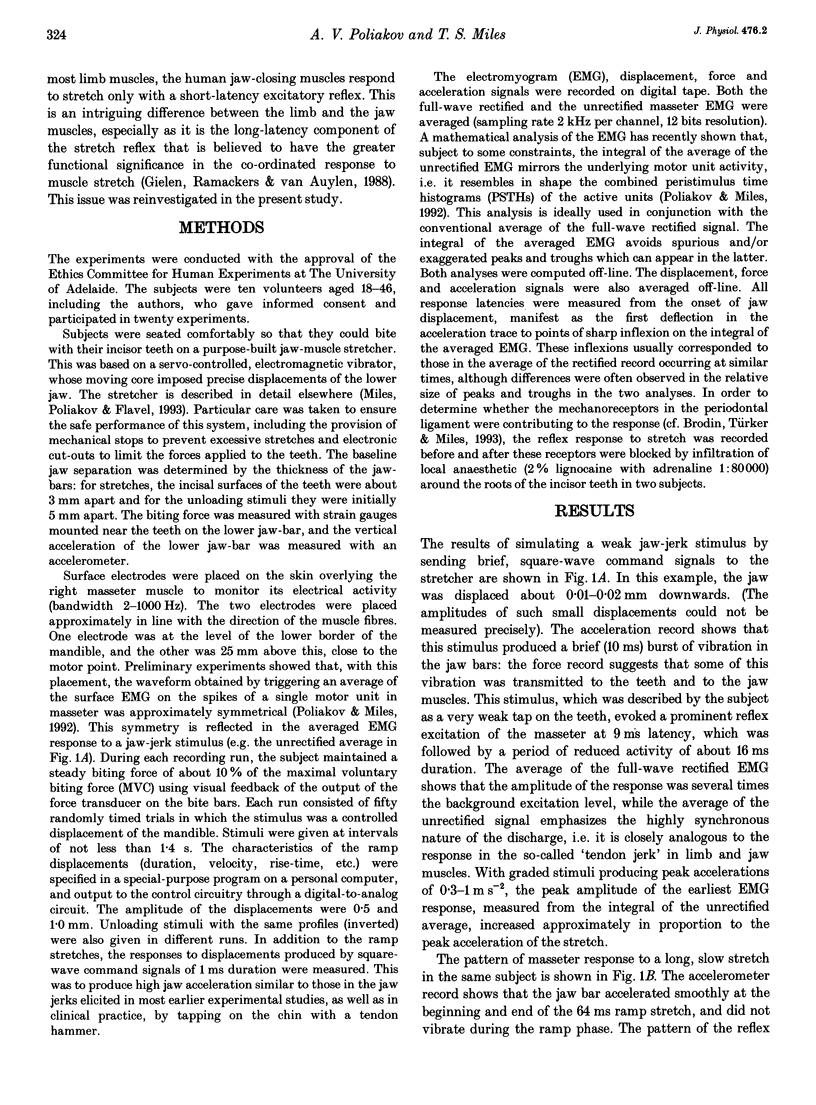
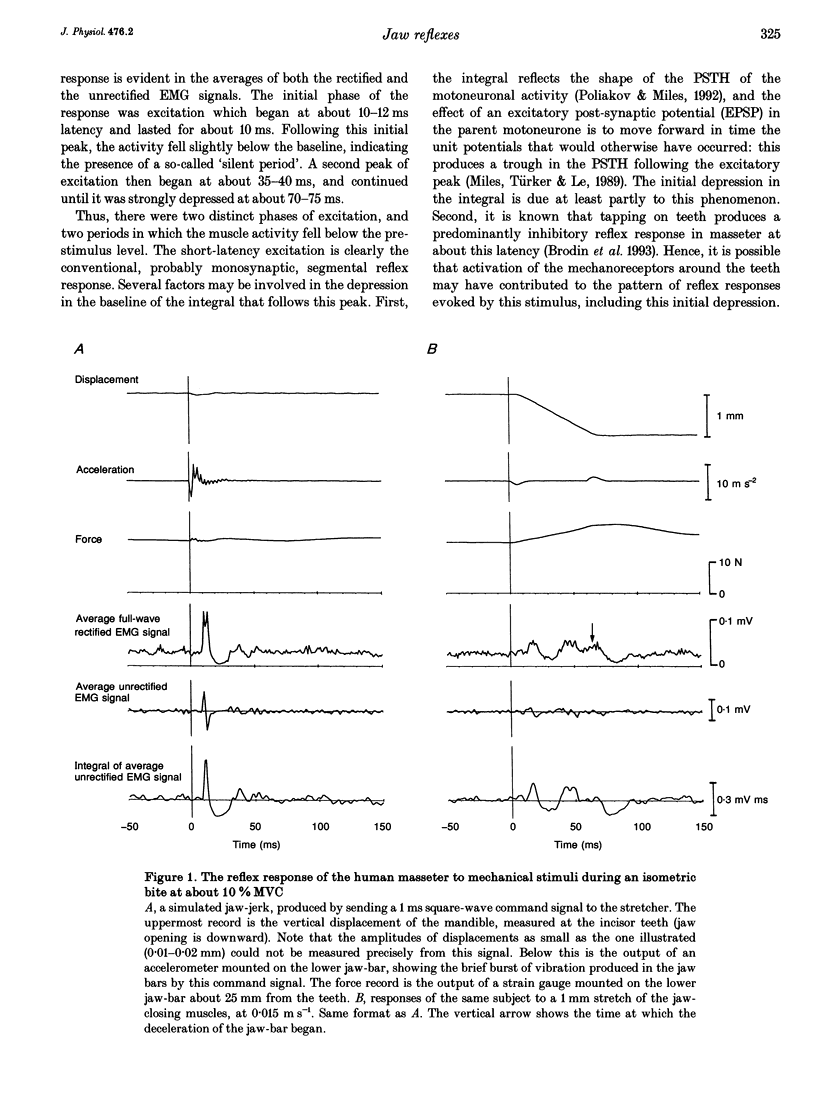
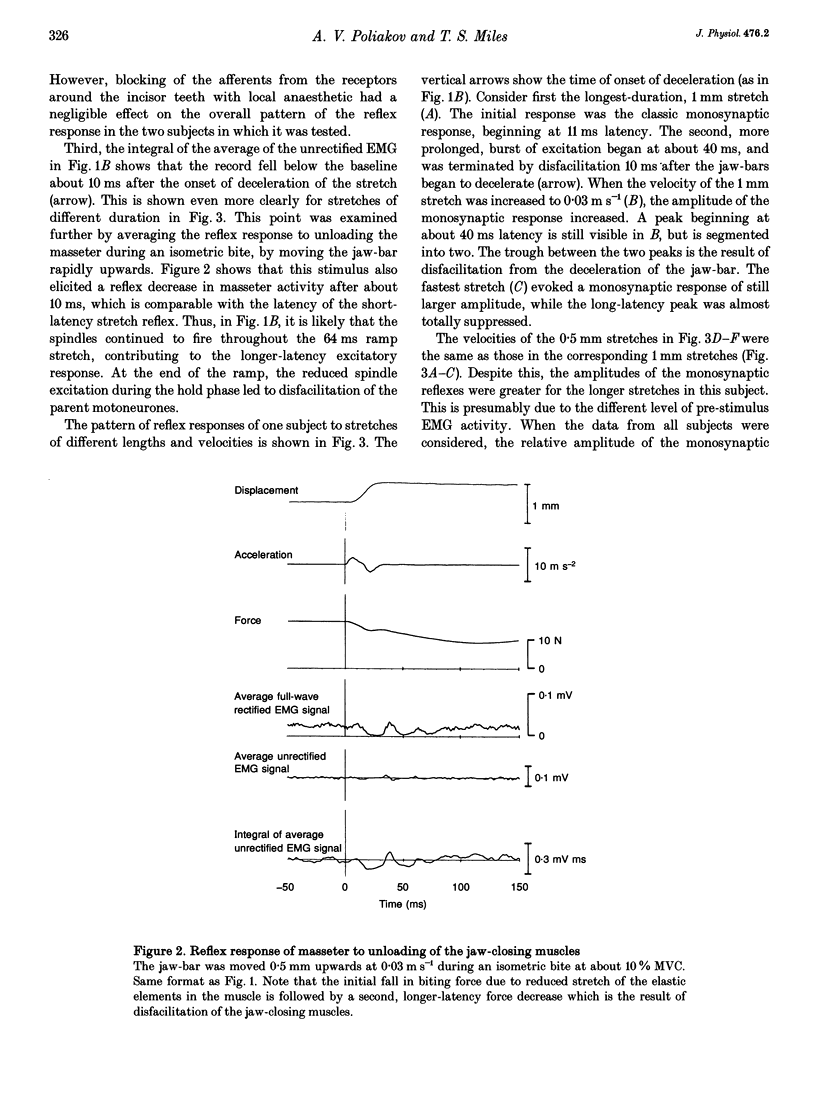
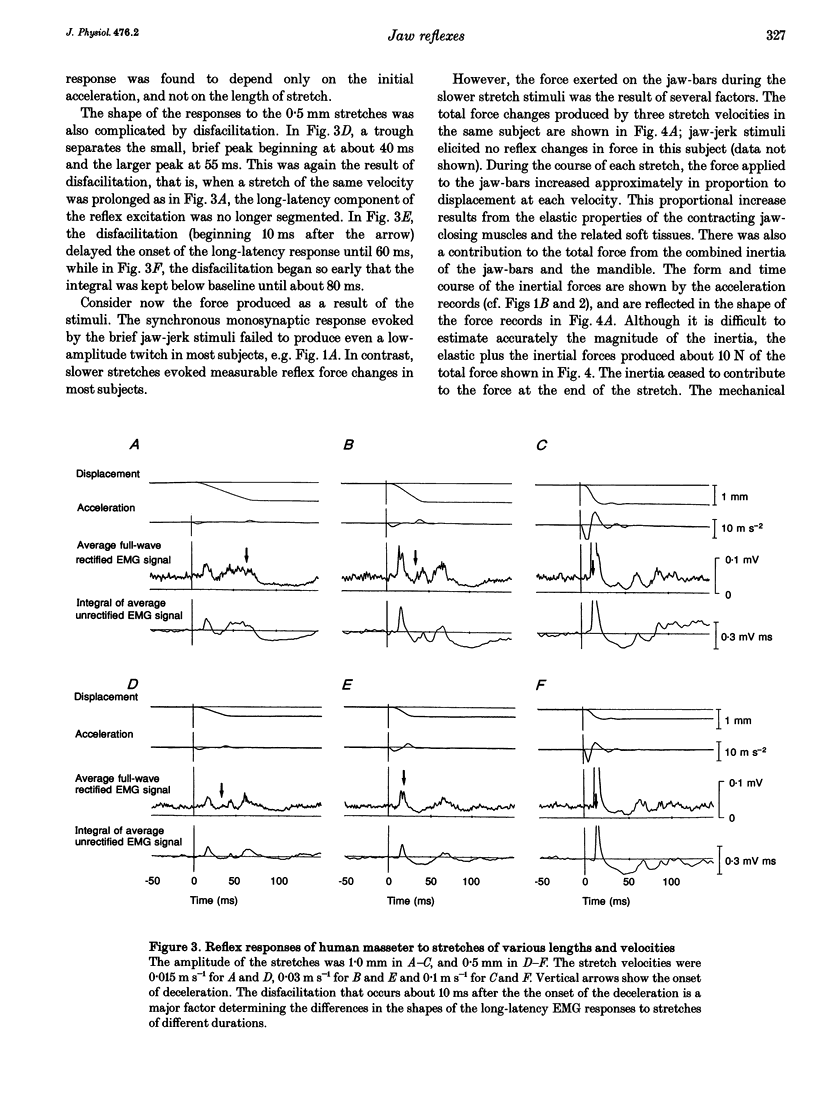
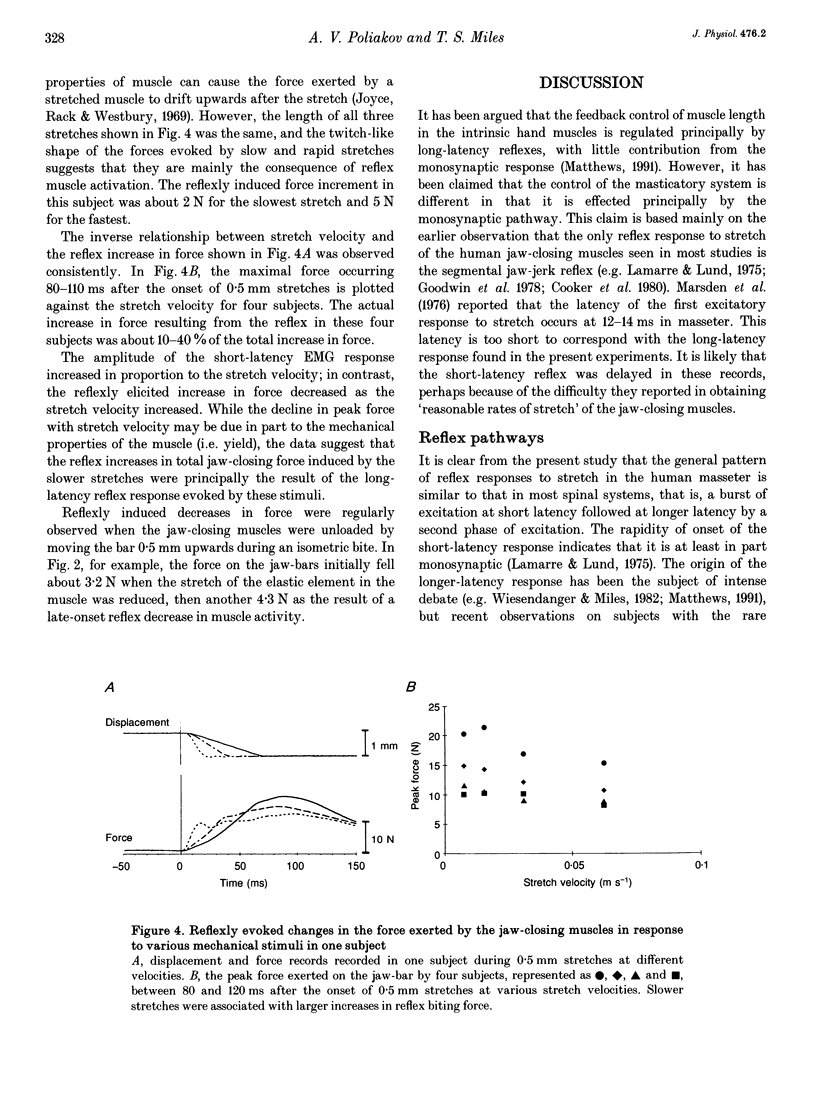
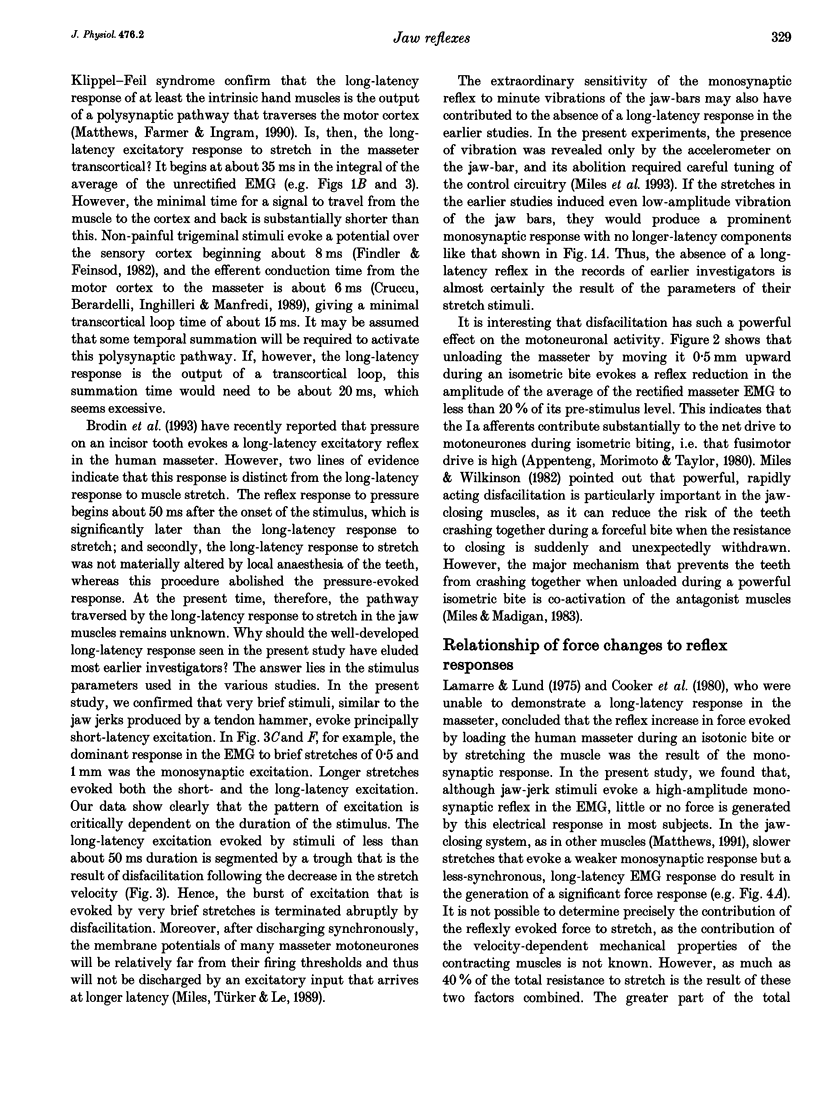

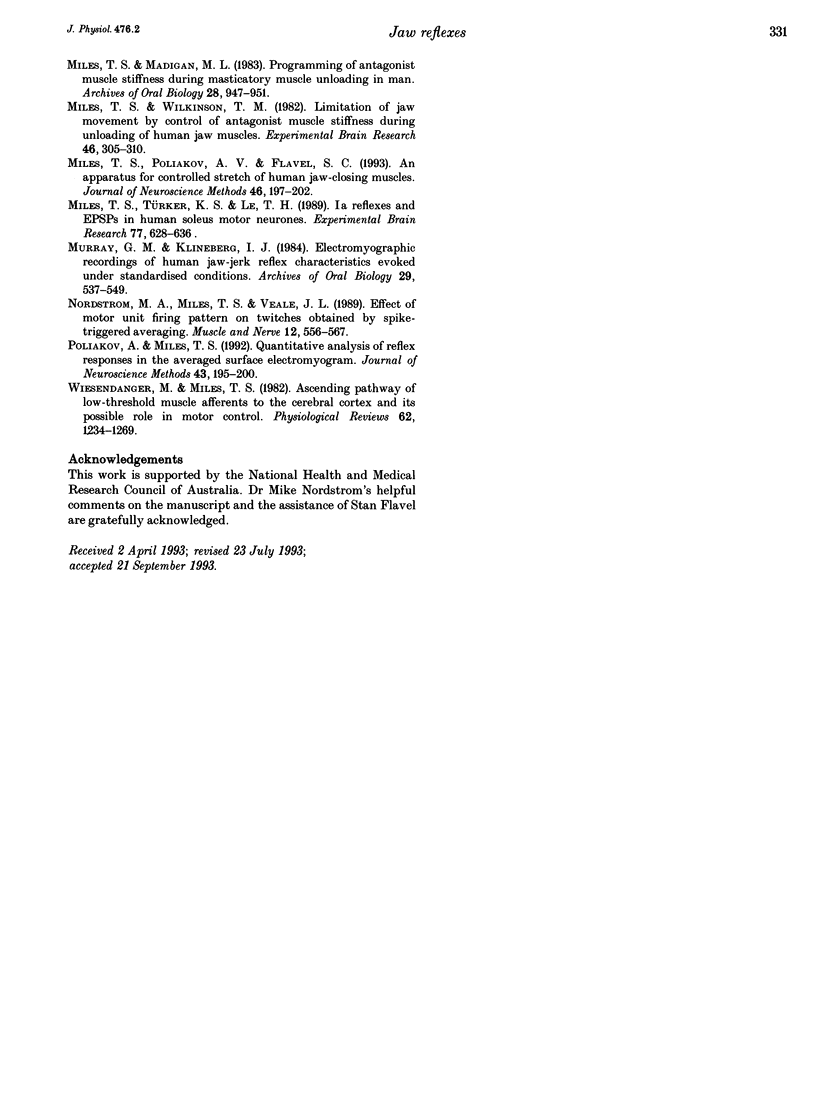
Selected References
These references are in PubMed. This may not be the complete list of references from this article.
- Appenteng K., Morimoto T., Taylor A. Fusimotor activity in masseter nerve of the cat during reflex jaw movements. J Physiol. 1980 Aug;305:415–431. doi: 10.1113/jphysiol.1980.sp013373. [DOI] [PMC free article] [PubMed] [Google Scholar]
- Appenteng K., O'Donovan M. J., Somjen G., Stephens J. A., Taylor A. The projection of jaw elevator muscle spindle afferents to fifth nerve motoneurones in the cat. J Physiol. 1978 Jun;279:409–423. doi: 10.1113/jphysiol.1978.sp012353. [DOI] [PMC free article] [PubMed] [Google Scholar]
- Brodin P., Türker K. S., Miles T. S. Mechanoreceptors around the tooth evoke inhibitory and excitatory reflexes in the human masseter muscle. J Physiol. 1993 May;464:711–723. doi: 10.1113/jphysiol.1993.sp019659. [DOI] [PMC free article] [PubMed] [Google Scholar]
- Cooker H. S., Larson C. R., Luschei E. S. Evidence that the human jaw stretch reflex increases the resistance of the mandible to small displacements. J Physiol. 1980 Nov;308:61–78. doi: 10.1113/jphysiol.1980.sp013462. [DOI] [PMC free article] [PubMed] [Google Scholar]
- Cruccu G., Berardelli A., Inghilleri M., Manfredi M. Functional organization of the trigeminal motor system in man. A neurophysiological study. Brain. 1989 Oct;112(Pt 5):1333–1350. doi: 10.1093/brain/112.5.1333. [DOI] [PubMed] [Google Scholar]
- Findler G., Feinsod M. Sensory evoked response to electrical stimulation of the trigeminal nerve in humans. J Neurosurg. 1982 Apr;56(4):545–549. doi: 10.3171/jns.1982.56.4.0545. [DOI] [PubMed] [Google Scholar]
- Gibbs C. H., Mahan P. E., Lundeen H. C., Brehnan K., Walsh E. K., Holbrook W. B. Occlusal forces during chewing and swallowing as measured by sound transmission. J Prosthet Dent. 1981 Oct;46(4):443–449. doi: 10.1016/0022-3913(81)90455-8. [DOI] [PubMed] [Google Scholar]
- Gielen C. C., Ramaekers L., van Zuylen E. J. Long-latency stretch reflexes as co-ordinated functional responses in man. J Physiol. 1988 Dec;407:275–292. doi: 10.1113/jphysiol.1988.sp017415. [DOI] [PMC free article] [PubMed] [Google Scholar]
- Godaux E., Desmedt J. E. Human masseter muscle: H- and tendon reflexes. Their paradoxical potentiation by muscle vibration. Arch Neurol. 1975 Apr;32(4):229–234. doi: 10.1001/archneur.1975.00490460045005. [DOI] [PubMed] [Google Scholar]
- Goodwin G. M., Hoffman D., Luschei E. S. The strength of the reflex response to sinusoidal stretch of monkey jaw closing muscles during voluntary contraction. J Physiol. 1978 Jun;279:81–111. doi: 10.1113/jphysiol.1978.sp012332. [DOI] [PMC free article] [PubMed] [Google Scholar]
- Joyce G. C., Rack P. M., Westbury D. R. The mechanical properties of cat soleus muscle during controlled lengthening and shortening movements. J Physiol. 1969 Oct;204(2):461–474. doi: 10.1113/jphysiol.1969.sp008924. [DOI] [PMC free article] [PubMed] [Google Scholar]
- Lamarre Y., Lund J. P. Load compensation in human masseter muscles. J Physiol. 1975 Dec;253(1):21–35. doi: 10.1113/jphysiol.1975.sp011177. [DOI] [PMC free article] [PubMed] [Google Scholar]
- Lund J. P., Drew T., Rossignol S. A study of jaw reflexes of the awake cat during mastication and locomotion. Brain Behav Evol. 1984;25(2-3):146–156. doi: 10.1159/000118860. [DOI] [PubMed] [Google Scholar]
- Marsden C. D., Merton P. A., Morton H. B. Stretch reflex and servo action in a variety of human muscles. J Physiol. 1976 Jul;259(2):531–560. doi: 10.1113/jphysiol.1976.sp011481. [DOI] [PMC free article] [PubMed] [Google Scholar]
- Matthews P. B., Farmer S. F., Ingram D. A. On the localization of the stretch reflex of intrinsic hand muscles in a patient with mirror movements. J Physiol. 1990 Sep;428:561–577. doi: 10.1113/jphysiol.1990.sp018228. [DOI] [PMC free article] [PubMed] [Google Scholar]
- Matthews P. B. The human stretch reflex and the motor cortex. Trends Neurosci. 1991 Mar;14(3):87–91. doi: 10.1016/0166-2236(91)90064-2. [DOI] [PubMed] [Google Scholar]
- McKenzie D. K., Gandevia S. C. Recovery from fatigue of human diaphragm and limb muscles. Respir Physiol. 1991 Apr;84(1):49–60. doi: 10.1016/0034-5687(91)90018-e. [DOI] [PubMed] [Google Scholar]
- Miles T. S., Madigan M. L. Programming of antagonist muscle stiffness during masticatory muscle unloading in man. Arch Oral Biol. 1983;28(10):947–951. doi: 10.1016/0003-9969(83)90091-2. [DOI] [PubMed] [Google Scholar]
- Miles T. S., Poliakov A. V., Flavel S. C. An apparatus for controlled stretch of human jaw-closing muscles. J Neurosci Methods. 1993 Mar;46(3):197–202. doi: 10.1016/0165-0270(93)90067-2. [DOI] [PubMed] [Google Scholar]
- Miles T. S., Türker K. S., Le T. H. Ia reflexes and EPSPs in human soleus motor neurones. Exp Brain Res. 1989;77(3):628–636. doi: 10.1007/BF00249616. [DOI] [PubMed] [Google Scholar]
- Miles T. S., Wilkinson T. M. Limitation of jaw movement by antagonist muscle stiffness during unloading of human jaw closing muscles. Exp Brain Res. 1982;46(2):305–310. doi: 10.1007/BF00237189. [DOI] [PubMed] [Google Scholar]
- Murray G. M., Klineberg I. J. Electromyographic recordings of human jaw-jerk reflex characteristics evoked under standardized conditions. Arch Oral Biol. 1984;29(7):537–549. doi: 10.1016/0003-9969(84)90075-x. [DOI] [PubMed] [Google Scholar]
- Nordstrom M. A., Miles T. S., Veale J. L. Effect of motor unit firing pattern on twitches obtained by spike-triggered averaging. Muscle Nerve. 1989 Jul;12(7):556–567. doi: 10.1002/mus.880120706. [DOI] [PubMed] [Google Scholar]
- Poliakov A. V., Miles T. S. Quantitative analysis of reflex responses in the averaged surface electromyogram. J Neurosci Methods. 1992 Jul;43(2-3):195–200. doi: 10.1016/0165-0270(92)90029-d. [DOI] [PubMed] [Google Scholar]
- Wiesendanger M., Miles T. S. Ascending pathway of low-threshold muscle afferents to the cerebral cortex and its possible role in motor control. Physiol Rev. 1982 Oct;62(4 Pt 1):1234–1270. doi: 10.1152/physrev.1982.62.4.1234. [DOI] [PubMed] [Google Scholar]


